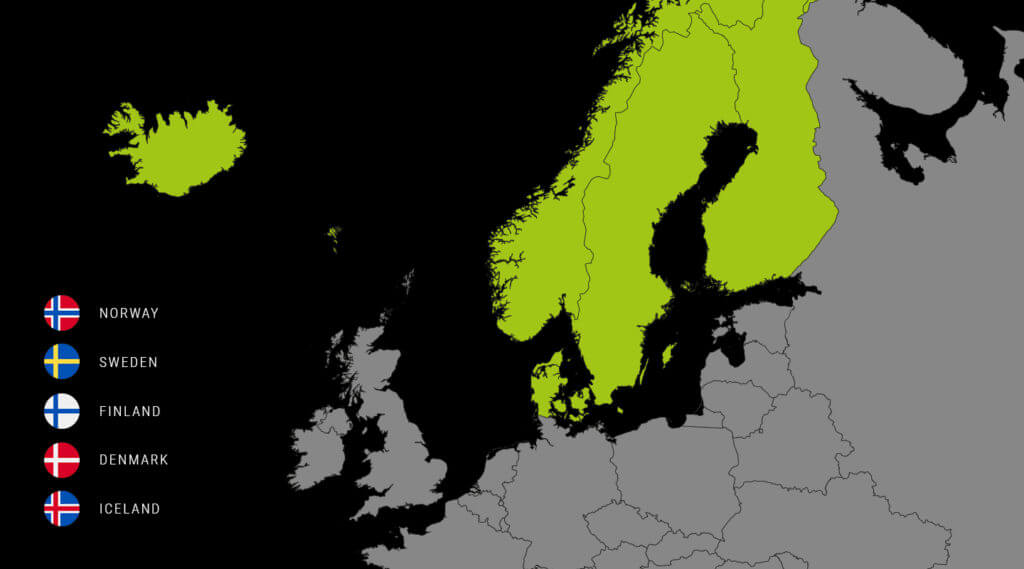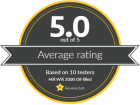Country Focus: Nordics
A hyper hygge competitive region
After Australia, Belgium and Poland, we’re taking on a major region this time. Describing the economics of a single country in 2,000 words is a challenge already, but doing the same for 5 different countries with multiple languages and currencies is damn near impossible. Nevertheless, we decided to cover the “Nordics” in one chapter of our Country Focus series. And we have several reasons for doing so.
First, most of the retail players that are relevant for the consumer electronics industry are active and dominant across the entire region. Second, the Nordics are always ranking among the most innovative regions in the world.
THE ECONOMY
The countries also stand out by being home to a notable share of world-leading companies, which by far exceeds the region’s share of the world economy. About 60 Nordic companies qualify for the Forbes list of the World’s 2000 largest publicly listed companies.
This significantly exceeds the numbers for Germany, the UK and the US, although the combined sizes of the Nordic economies is significantly less than half of that of those countries.
The Nordic’s GDP per capita is bigger than any other EU country and almost twice the average of all countries in the European Union. The Nordic countries harbour about 5% of the total population in the European Union but deliver almost 10% of the total GDP.
Next to high production efficiency (about 40% higher than the average of all EU countries, a third higher than Germany and 27% higher than UK), the region also has one of the highest purchasing power levels in the whole world, with disposable income about 20% higher than the European average.
Despite the Nordics encompassing five countries with five languages and cultures, consumer preferences are relatively homogeneous compared with those of other European countries. Nordic consumers are early adopters, and when it comes to technology, it isn’t any different. They have the highest Internet (97%) and smartphone penetration (96%) in Europe [source].
THE ECOSYSTEM
Where the CE market is concerned, most people probably know the Nordics as a hub for innovative brands in Europe with names like Bang & Olufsen, Genelec, Audio Pro and Zound Industries (responsible for iconic brands like Marshall and Urbanears) in the audio market, Aarke and Electrolux in home accessories and Blueair as one of the most decorated brands for air purifiers.
Meanwhile, home office communication has long been synonymous with names like Jabra and Skype, and everyone is using Spotify, a distinctly Swedish innovation.
According to Deloitte, the Swedish market is mature. Growth is driven mainly by innovation and replacement needs for consumer electronics – especially as Swedes are early adopters and conscious shoppers.
Changing demographics and sociological trends, for instance to more single-person households, support long-term demands for housing, household goods, healthcare and leisure, while the spending patterns of an ageing population shift from clothing to pharma and health products as well as high-end leisure activities.
The Danish consumer market is small by European standards. Denmark has a population of about 5.75m (which, prior to the pandemic, was forecast to grow by about 0.4% between 2019 and 2023).
When we look at the largest players in the consumer electronics market, one company stands out: ELKJØP. Active in all Nordic countries with approx. 415 stores (including franchise) and a total revenue of 42 billion NOK (4.14 bil €) in 2019/2020, the company was bought in November 1999 by Dixons Carphone (owner of Currys PC World) and is the largest CE retailer in the Nordics (known as ELKJØP in Norway, Elgiganten in Sweden and Denmark, Gigantti in Finland and Elko in Iceland).
Despite Corona, ELKJØP managed to grow by 4.4% in the last fiscal year. According to their annual report, their vision is to help everyone enjoy amazing technology. They want to make sure no one is left behind as one in three worries that more people will be excluded from society due to rapid technological developments.
The group has heavily invested in e-commerce transformation in the past few years, with the addition of their own customer club only happening in 2019 and just recently announcing the formation of a new center of excellence for performance marketing. Scandinavia’s leading provider of electronic goods achieved a one-third increase in online revenue in just one year.
The company is pursuing an omnichannel strategy to create a rich and ubiquitous customer experience – from its brick and mortar stores and online shop to its customer service center.
The number two in the region is Power, active in Norway, Denmark and Finland with approx. 190 stores (including franchise) and a revenue of 11.5 billion NOK (1.13 bil €) in 2019 (excluding franchise). Interestingly, 45% of Power are owned by the Awilhelmsen Group, originally a shipowner company from Norway and in our industry mainly known as owners of Royal Caribbean Cruise Line.
Other big names include MediaMarkt, NetOnNet, ELON and Euronics (in Sweden and Denmark). Most notably, the e-commerce player NetOnNet dominates the the online market with more than US$ 300m in online sales in Sweden in 2019 alone. This is followed by Elgiganten, Kjell & Company, Webhallen and komplett.se, which all focus on the Swedish market with a turnover north of 100m EUR.
Another noteworthy player is CDON, the Nordic’s largest marketplace, a platform that connects +1,500 third-party sellers with 2.3 million active customers (around 8% of the Nordic population). They claim that 88% of the Nordic population is aware of the brand and they communicate with more than 100m visitors per year.
CDON’s new marketplace business model (since 2017/2018) earns high gross margins above 90% according to redeye’s latest equity research. CDON does not tie capital up in inventory; instead, it operates as a merchant of merchants (B2B), helping third-party sellers connect to a large Nordic customer base and benefit from low customer acquisition costs.
Nordic e-commerce grew by above 10% CAGR in the last decade and by ~40% in 2020 due to the pandemic and social distancing measures. CDON is set to grow faster than the overall market if history is any indication. CDON’s effective take rate is 11.5% (marketplace sales/gross merchandise value), while the international benchmark sits at approximately 15%, indicating that CDON’s platform is under-monetized. However, the arrival of Amazon in the Swedish market in October 2020 might change the competitive landscape dramatically.
Other than the three previously mentioned players, there is ProShop from Denmark, a pure-play online store that started in 1995 and now makes about 280m Euro in turnover per year with mainly IT and electronics. Finally, there is Dustin, which focuses on the B2B and SME market but also has a small (5% of the total business) B2C arm. Outside of the Nordics, business in the Netherlands is also significant.
Overall, the value of ecommerce in the Nordics ranges from 9.39bn EUR in Sweden to 5.73bn in Denmark to 5.63bn in Norway to 3.26bn in Finland [source]. While Swedes seem to buy most foreign wares from Germany, Danes go shopping in the UK and Fins and Norwegians buy most products from China directly.
INFLUENCERS
Some of the most popular Nordic influencers include:
- Felix Kjelberg: Comedy & gaming (21.8m IG followers)
- Greta Thunberg: Climate activism (11m IG followers)
- Anna Nyström: Fitness & lifestyle (8.3m IG followers)
- Elsa Hosk: Fashion (6.5m IG followers)
- Maher Zain: Music (5.2m IG followers)
- “Skill Twins” Josef & Jacob Elzein: Sports and entertainment (1.3m IG followers)
Lyd & billed and Recordere are the top advise-seeking platforms, and bargain hunters like to go to sites such as Prisjakt (exists in Norway, Finland & Sweden, 7.39m total visits in 6 months) and Pricerunner (Swedish origin; 6.19m visits in the last 6 months).
Where traditional media outlets are concerned, a number of TV shows focus on tech products, most notably TV2 Go´morgen in Denmark and TV2 Hjelper dig (with product tests in Norway). The most popular traditional news outlets per country are the following:
- Sweden: Aftonbladet
- Finland: Helsingin Sanomat
- Norway: Verdens Gang
- Denmark: B.T.
- Iceland: Fréttablaðið
CONSUMER ELECTRONIC BRANDS
The Nordics are home to a number of well-reputed consumer electronic brands. From staples Nokia and Ericsson to the Electrolux conglomerate to audio giants like Zound Industries, Genelec and Bang & Olufsen. The landscape is similar to the rest of Europe, with the exception that these brands have much higher market shares at home than outside the Nordics.
In the professional audio and communications market, Jabra takes an established leading position. Part of the GN group, they are not just leading providers of office communication, but also of consumer devices and hearing apparatuses (ReSound).
Electrolux dominates the home accessories market with refrigerators, freezers, ovens, cookers, hobs, hoods, microwave ovens, dishwashers, washing machines, tumble dryers, vacuum cleaners, air conditioners, air purifiers and smaller domestic gadgets.
However, local players like Aarke, Wilfa (coffee), OBH Nordica and Blueair eat away a fair share of Electrolux revenues by providing stylish and well-designed alternatives to the incumbent.
GoPro is the main player in the action gear market, with Sony, Insta360 and Xiaomi catching up and companies like Garmin now entering the segment.
AQIPA INSIGHTS
Despite being treated as one region for many brands and distributors, there are of course differences between the 5 countries, and it is important to understand the local nuances. 5 countries with 5 different languages, cultures, currencies, and different VAT rates (25% for Sweden, Denmark & Norway; 24% for Finland & Iceland), especially in relation to the rest of Europe.
Margin expectations for retailers are very high, with the typical back-conditions known from other countries being the exception rather than the norm. Listing fees are applied for major retailers and AAA brands.
The most important difference to other European markets is of course the significantly higher price level in the Nordics. This is paired with a very high level of expectation for aftersales services.
Although the Nordics have a reputation for being “design-driven”, our team feels that retailers are going to further build and expand on “experience” areas where consumers can forego a transaction and actually experience and feel the products they want to purchase.
Compared to the rest of Europe, the Nordic retail landscape seems more innovative and daring as well as more reactive and adaptive to new concepts and store formats. Aqipa’s Nordic team has an impressive range of experience and diversity, at least in backgrounds if not in gender – we still have a way to go there in all regions 😉
The team has a strong network within the hi-fi and audio/video business with the right decision-making contacts at retailers like ELKJØP, Power and most other major CE/whitegoods retailers and online players in the Nordic market.
For any questions regarding Aqipa services in Denmark, Sweden, Finland, Norway or Iceland, feel free to contact our Nordics gear guru Thomas Baes.






